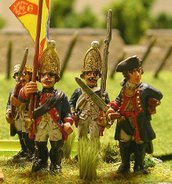The bases are 3mm arctic birch plywood. The rocks are coarse cork from bulletin board sections, glued down then chipped up using a fingernail. After they're chipped I glued the extra broken bits on top to keep them from looking too regular. Once the base and rock troughs are made the filter material is painted green, flocked and glued in. After the glue is dry sticks for trees are glued in along with foliage clusters, model railroad vines and the odd tuft of long grass. All of this final step is done in one go. These four sections took me two one-hour sessions and a two-hour session on three consecutive nights. They're labor intensive, but I really like the look, so I think they're worth the work. The only materials that cost all that much are the model railroad foliage clusters. For enough bocage to fill a table I'll probably go through 6-8 bags of clusters.


These are a couple work-in-progress shots of a 28mm windmill I've been working on for use on 7YW, Napoleonic and possibly even the odd WWII table. I still have a lot of painting and detail work to do, but the base framework is there. The main body is made from a hard plastic cup from the dollar store. The top section was originally turned on my wood lathe, then the face section was added and built-up using 1/64" thick model aircraft plywood. The shingles are card stock cut in strips on my laser engraver and glued down mostly by hand. For reference that is a 28mm French Napoleonic officer on a 4mm thick base. The windmill vane assembly is removable for storage and transportation. I've laser cut the grids on it, but I may replace it with something a bit more delicate, possibly some metal screening. After looking at the photos and comparing them to actual windmill photos, I also think I need to make the vanes larger in diameter.









3 comments:
Lovely hedges AJ!
They look just right!
Cool, nicely done!
Post a Comment